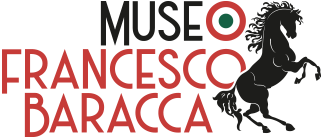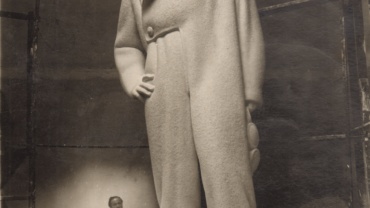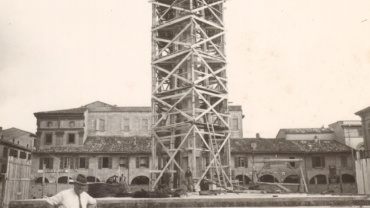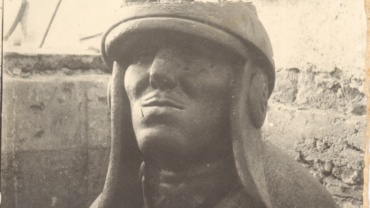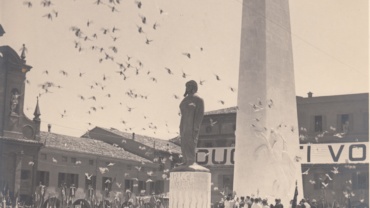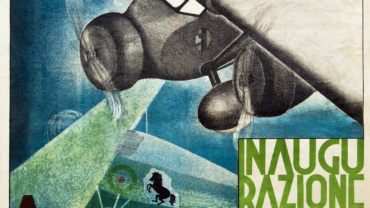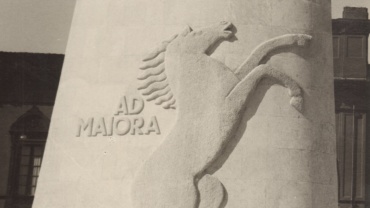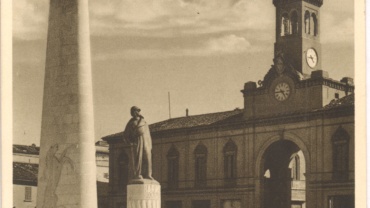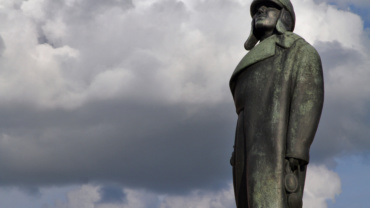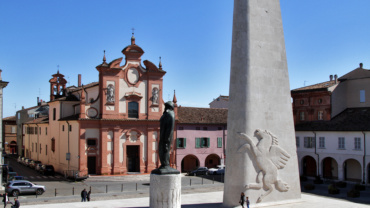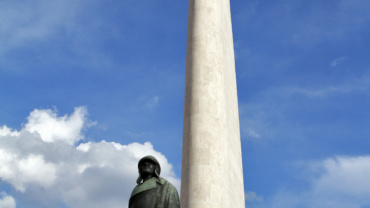The Rambelli Monument
Immediately after Francesco Baracca’s death, initiatives were promoted to celebrate the hero. On the 30th of June 1918, day of the funeral in his hometown, in the columns of Lugo’s Republican periodical “La Vedetta”, the construction of a monument to Baracca “in Lugo’s main square” was already being planned. A designated committee was therefore created, headed by the mayor of Lugo, to raise the necessary funds. The subscription raised the commitment of a plurality of people, ranging from Veneto’s refugees to individual citizens and industrial groups. Very soon, in September 1918, it became necessary to set up a national coordination committee in Rome, under the chairmanship first of Vittorio Emanuele Orlando, President of the Council of Ministers, and later of Emanuele Filiberto, Duke of Aosta.
In 1925, after a few years characterised by bureaucratic delays and discussions, some committee members from Lugo went to Rome for a talk with Mussolini, who invited them to turn directly to a renowned artist, avoiding useless competition procedures. Thanks to the decisive intervention of Margherita Sarfatti, who suggested Domenico Rambelli to consider the opportunity of designing a monument of national character, and to the numerous letters of encouragement from Filippo Tommaso Marinetti, Ugo Ojetti, Massimo Bontempelli and Francesco Balilla Pratella from Lugo, the artist from Faenza accepted the commission. Back from the prestigious realisations of the Monumento ai Caduti (War Memorial) in Viareggio and the Fante Dormiente (Dormant Infantryman) in Brisighella, Rambelli began an intense production of drawings and design studies that covered the years from 1927 to 1935. Initially, the site for the monument was not the town centre. Several hypotheses were formulated, such as the public garden in front of the station or, after 1930, near the airfield in Villa S. Martino. It is therefore not surprising that there were sketches and drafts of a circular, temple-like structure with two tiers of steps, 34 columns – as many as Baracca’s victories – and a statue of the hero in the centre.
Once definitively established the site of the monument in Piazza XX Settembre, Rambelli aimed for a monumental, expressionist and symbolic structure, where a colossal and stylised wing serves as backdrop to the statue of the hero, placed on a plinth reporting the dates and places of the victories. The straight and massive figure of Baracca is characterised by an absorbed posture and a summary description of the aviator’s features: glasses, helmet and suit.
In November 1935, for the monument’s positioning, considerable masonry work had to be carried out, such as the gutting and subsequent repaving of the square.
The monument, inaugurated on the 21st of June 1936 in the presence of the Duke of Aosta as well as of the regime’s top hierarchs, covers an area of 1040 square metres, entirely clad in Tivoli travertine.
On the flanks of the 27-metre-high wing are carved in low relief the symbols of the divisions to which Baracca belonged in Cavalry and Aviation: the prancing horse with the motto “Ad Maiora” and the Pegasus, demonstrating Baracca’s evolution into a knight of the sky.
The statue reaches a height of 5.70 metres and stands on a cylindrical boulder where, in addition to the aforementioned victories, stylised flames and the dedication ‘Baracca invitta ala d’Italia nella grande guerra’ (Baracca, invincible wing of Italy in the Great War) are carved between a propeller and a machine gun.
Gallery
Video
Podcast
The Baracca Museum represents the starting point of a city itinerary that includes the Monument, designed and concluded in 1936 by sculptor Domenico Rambelli from Faenza and considered as one of the greatest expressions of Italian Twentieth Century culture, as well as the Sala Baracca in the Rocca Estense, first seat of the Museum, decorated with frescoes by painter Lucio Benini and wooden furnishings by Antonio Turri, both artists from Lugo.
In addition, in the city cemetery it is possible to visit the burial Chapel of the Baracca family, where the majestic bronze sarcophagus enclosing the Ace’s remains may be admired. The apsidal niche, ideated by artist Roberto Sella, presents a mosaic decoration inspired by Liberty and Art Decò styles


